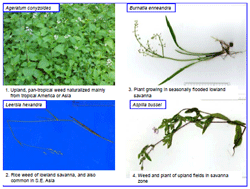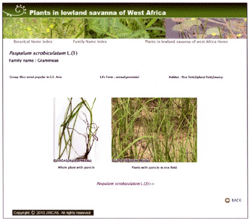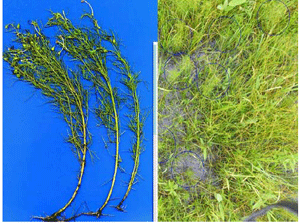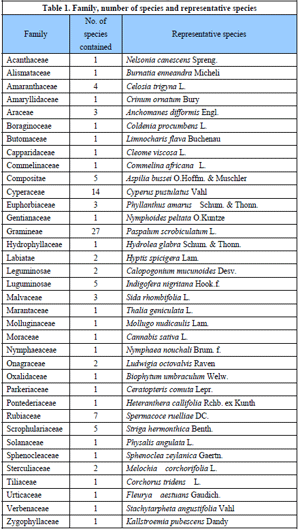Establishment of a database on weed species in lowland Savanna in West Africa
Description
Practical information on identification of weeds and wild plants occurring in lowland conditions has become even more essential for the development of an effective weed management system geared towards the improvement of rice production in the flood-plains of West Africa, because WEEDS OF RICE in West Africa (D. E. Johnson 1997), which had been a valuable source on identification and biology of rice weeds in West Africa, had been out of print for a long time. Therefore, the establishment of a database on the weeds and plants in the abovementioned environment where a JIRCAS Project “Development of low input, sustainable rice cultivation system in flood plains in Africa” has been carried out, was needed to provide correct information to the Project.
Major weed species, including wild native plants collected in/around ricefields of lowland savanna in the northern part of the Republic of Ghana, were identified based on herbal specimens and photographic images reproduced by a high resolution scanner. Each species was classified, based on its origin as given in the literatures, into four groups: 1) Upland pan-tropical weeds naturalized mainly from tropical America or Asia, 2) Rice weeds of lowland savanna, and also common in Southeast Asia, 3) Plants growing in seasonally flooded lowland savanna, and 4) Weeds and plants of upland fields in the savanna zone, as shown in Fig. 1, with representative species. The weed species distribution, which was differentiated from field to field, reflects the history and management practices in each rice field (data not shown).
A database, “Plants in lowland savanna of West Africa”, with images, scientific names, classified origin and biological information of approximately 110 species had been uploaded to the website of JIRCAS (https://www.jircas.affrc.go.jp/DB/DB06/index.html) (Fig. 2 and Table 1). Considering the frequency of occurrence, plant size, possible flood tolerance and so on, species such as Paspalum scrobiculatum, Arcoceras zizanioides, Aspilia paludosa and Melochia corchorifolia were nominated as noxious rice weeds in the Project site. A wild rice, Oryza longistaminata should be treated with caution because it was found to have grown in conventional rice fields in northern Ghana. A semi-parasitic species, Rhamphicarpa fistulosa, growing under flooded conditions and reported as a parasite to Gramineous plants including rice, was likewise discovered in the Project site (Fig. 3). This species is also a possible threat.
The results can be utilized as basic information on changes of weeds and natural vegetation for the development of rice cultivation in the flood plains of West Africa. Though weed species can be searched by scientific names, these are searchable as well among images belonging to one family if the user could identify the family name of the species. This database will be further revised and enlarged through further investigations on the weed flora and weed biology in the ricefields of lowland savanna of West Africa.
Figure, table
-
Fig 1. Groups with representative species of weeds from different origin.
-
Fig. 2. A page from the database, “Plants in lowland savanna of West Africa”, showing Paspalum scrobiculatum, a possible noxious grass weed in rice fields.
-
Fig. 3. A semi-parasitic weed Rhamphicarpa fistulosa, growing under a flooded field (right: in circles) and flowering plants (left). -
Table 1. Family, number of species and representative species in the database
- Affiliation
-
Japan International Research Center for Agricultural Sciences Crop Production and Environment Division
- Classification
-
Administration B
- Term of research
-
FY2009~2010
- Responsible researcher
-
SAKAGAMI Jun-Ichi ( Crop Production and Environment Division )
MORITA Hirohiko ( Akita Prefectural University )
UCHINO Akira ( NARO Agricultural Research Center )
- ほか
- Publication, etc.
-
Morita et al. (2010) Journal of weed science and technology 55(Suppl):66.
Morita et al. (2010) Characteristics of weed flora in rice fields of lowland savanna of Ghana. 3rd International Rice Congress:98.
- Japanese PDF
-
2010_seikajouhou_A4_ja_Part23.pdf102.49 KB




